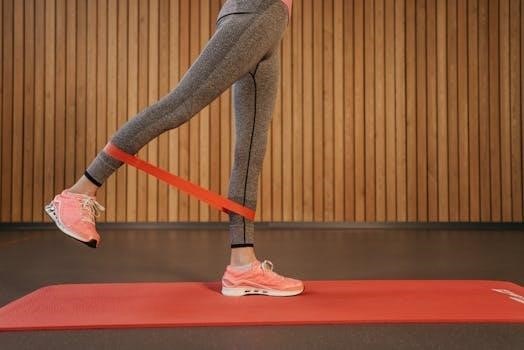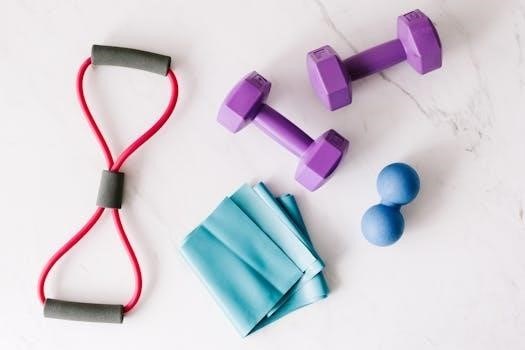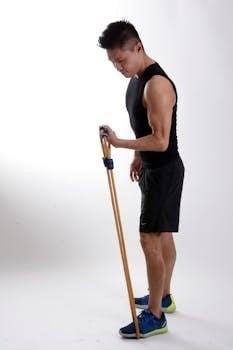Resistance bands offer a low-impact yet effective way to strengthen muscles around the knee. These exercises are versatile and can be tailored to different needs, from rehabilitation to arthritis management. They improve stability and reduce pain.
Benefits of Using Resistance Bands for Knee Pain
Resistance bands provide a unique approach to managing knee pain, offering numerous advantages over traditional weight training. They allow for low-impact exercises, minimizing stress on the joints while effectively strengthening the surrounding muscles. This is especially beneficial for individuals with conditions like osteoarthritis or those recovering from injuries. Using resistance bands can improve knee stability and mobility by targeting the muscles that support the joint, such as the quadriceps, hamstrings, and glutes. These exercises also help reduce inflammation and alleviate pain by promoting better joint alignment and function. Furthermore, resistance bands are versatile, portable, and easily adjustable to different fitness levels, making them a convenient and accessible tool for anyone seeking relief from knee discomfort. Regular use of resistance bands can lead to stronger knees, enhanced range of motion, and a reduction in pain during daily activities, ultimately improving overall knee health and quality of life. They also allow to strengthen tendons and connective tissue, without hard impact.

Understanding Knee Pain and Resistance Bands
Knee pain is a common issue that can stem from various causes. Resistance bands are increasingly recognized for their efficiency in alleviating knee pain by targeting the muscles around the knee joint.
Effectiveness of Resistance Bands for Knee Pain Relief
Resistance bands are a valuable tool for knee pain relief due to their low-impact nature, which allows for strengthening without excessive stress on the joints. They enable targeted muscle engagement around the knee, promoting stability and reducing pressure. These bands are effective in improving mobility and alleviating pain, making them ideal for physical therapy. Additionally, they are versatile and adaptable to varying fitness levels, and can be used at home or in a gym setting. By using resistance bands, individuals can strengthen tendons, connective tissues, and muscles around the knees. This reduces inflammation and increases overall knee health. Regular use can lead to significant improvements in knee strength and a decrease in pain during activity. They are also a safe option for people who may be at risk of injury with heavy weights.

Essential Warm-up and Safety Precautions
Before starting resistance band exercises, warming up is essential. Gentle stretching or a short walk prepares muscles. If discomfort arises, stop the exercise. Safety is a priority when exercising.
Importance of Warming Up Before Exercises
Prioritizing a proper warm-up is crucial before engaging in any resistance band exercises for knee pain. A warm-up prepares your muscles for the upcoming activity, reducing the risk of injury. Gentle movements, such as a leisurely walk or light stretching, can increase blood flow to the muscles surrounding the knee, enhancing their flexibility and responsiveness. This preparation is essential for preventing strains and tears. Additionally, a warm-up helps to improve joint mobility, which is important for executing exercises with correct form. Warming up is not just a suggestion; it is a necessity for a safe and effective workout. It allows your body to transition smoothly into the exercise routine, maximizing the benefits while minimizing the potential for harm. Remember, a few minutes of preparation can make a significant difference in your overall workout experience and long-term knee health.

Specific Resistance Band Exercises for Knee Pain
This section details effective resistance band exercises targeting muscles around the knee. These exercises enhance stability, reduce pain, and improve overall knee function, aiding in rehabilitation and strengthening.
Front Leg Extension
The front leg extension is a fundamental exercise for strengthening the quadriceps, crucial for knee stability and pain reduction. To perform this exercise, sit on a chair with your feet flat on the floor. Secure a resistance band around your ankles. Slowly extend one leg straight out in front of you, feeling the tension in your quadriceps. Hold for a moment, then slowly lower your leg back to the starting position. Ensure your movements are controlled and avoid jerking. Repeat this exercise for the desired number of repetitions, then switch to the other leg. This exercise helps isolate and strengthen the quadriceps muscles, which support the knee joint and contribute to reduced knee pain. Remember to maintain good posture and engage your core throughout the exercise to maximize benefits and avoid any unnecessary strain.
Terminal Knee Extension
Terminal knee extensions are vital for strengthening the muscles that support the knee at full extension, an often-overlooked aspect of knee health. To perform this exercise, secure a resistance band around a stable object at ankle height. Stand with your leg inside the band, and slightly bend your knee. Slowly extend your knee fully, feeling the tension increase in your quadriceps. Hold briefly, then slowly return to the starting position. Focus on controlled movements to avoid any sudden strain. Ensure your knee is fully extended at the end of the movement. Repeat this exercise for the desired number of repetitions before switching to the other leg. This exercise is particularly beneficial for improving knee stability and reducing pain, especially in the final degrees of knee extension. Maintain good posture and a stable stance throughout the exercise.
Lying Knee Extension
The lying knee extension is a great exercise for isolating and strengthening the quadriceps muscles, which are crucial for knee support and stability. To perform this exercise, lie on your back with your legs extended. Secure a resistance band around one ankle, holding the other end with your hands or securing it to a stable object. Slowly extend your leg straight up, keeping your knee as straight as possible. You will feel tension in the quadriceps; Hold for a moment, and then slowly lower your leg back down to the starting position. Maintain a slow, controlled movement throughout the exercise to avoid jerky motions. Repeat this exercise for the desired number of repetitions before switching to the other leg. This exercise is low impact and can be easily modified to suit different fitness levels. It helps to improve the strength and function of the knee joint.
Clamshells Exercise
Clamshells are an excellent exercise for targeting the muscles around the hips and thighs, which provide crucial stability to the knees. To perform the clamshell exercise, lie on your side with your knees bent and stacked on top of each other. Place a resistance band around your thighs, just above your knees. Keep your feet together while slowly lifting your top knee, like a clamshell opening, while keeping your hips stable. Avoid rotating your hips backwards as you lift your knee. Feel the engagement in your glute muscles. Slowly lower your knee back to the starting position. The movement should be slow and controlled. Repeat the desired number of repetitions on one side before switching to the other. This exercise is ideal for strengthening hip abductors, which play a key role in stabilizing the knee joint and preventing knee pain. They are effective for improving knee health.
Lying Glute Extension
The lying glute extension is a primary glute exercise within this resistance band series. Tight glutes can cause tight hamstrings, which in turn can pull against the quads, potentially leading to knee pain. To perform this exercise, begin by lying face up on the floor with one leg bent and the foot flat on the floor. The other leg should be straight. Place a resistance band around the ankle of the straight leg. Engage your glutes and lift the straight leg off the floor. The movement should be controlled and you need to focus on squeezing your glutes at the top of the movement. Lower your leg slowly back to the starting position. Repeat the desired number of repetitions on one side before switching to the other leg. This exercise is great for improving hip extension and glute strength, which are vital for supporting healthy knee function and reducing pain.

Conclusion and Recommendations
Integrating resistance band exercises into your routine can significantly reduce knee pain and improve strength. These exercises are adaptable and effective for various fitness levels, promoting overall knee health and stability.
Integrating Resistance Band Exercises into Your Routine
To effectively integrate resistance band exercises into your routine, begin with a proper warm-up, such as a light walk or gentle stretches, to prepare your muscles. Start with a low-resistance band and gradually increase the resistance as you get stronger. Consistency is key; aim to perform these exercises several times a week for optimal results. Pay close attention to your body, and if you experience any pain, stop immediately. It’s important to maintain proper form throughout each exercise to avoid injury and maximize the benefits. Combine these exercises with other forms of low-impact activities like swimming or cycling for a well-rounded approach to knee health. Remember that patience and persistence are vital to seeing long-term improvements in your knee strength and pain reduction. Adjust the intensity and frequency based on your specific needs and progress. Consider consulting with a healthcare professional or physical therapist for personalized guidance if necessary.

